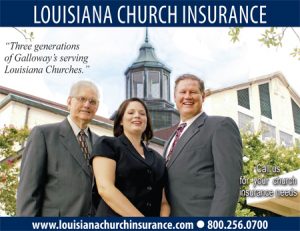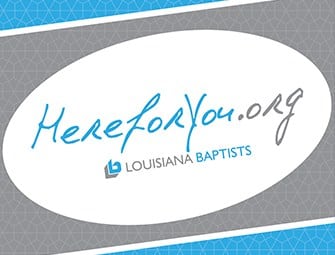By Don F. Mabry and Ed Jelks
ALEXANDRIA, La. (LBM) — The Louisiana Baptist Mission Builder program started with the Lord calling Ed Jelks to build mission church buildings, and to stop building barns, as a bi-vocational pastor.
Ed was attending Home Mission Week at Ridgecrest, North Carolina, when he sought out Leon Hyatt, director of the Cooperative Missions Department of the Louisiana Baptist Convention. Ed did not know it, but the Louisiana Baptist Missions Team had been praying for, and discussing the need for somebody to direct a program to construct buildings for mission churches in Louisiana.
Ed Jelks and Leon Hyatt discussed how such a program could be started, then went and found Don Mabry on the front porch of the auditorium at Ridgecrest. They discussed with him what they had been talking about and the dreams that they had, and wanted to know if such a thing could be done. Don’s reaction was, “Well, we do not have any budget, and it has never been approved by the Convention’s administration or the Executive Board of the LBC. But, yes, there is a need, and with some more discussion and planning, it could be done.”
In November 1979, the Louisiana Baptist Executive Board Missions Committee approved the Mission Builder program; and a trial project was initiated for a small renovation at Pleasant Hill Baptist Church in Pine Grove.
On January 1, 1980, Ed Jelks began his service as the director of Mission Builders.
At first, he drew floor plans, developed budgets, recruited volunteers, and supervised the construction of mission church buildings.
Also, in the beginning there was no LBC budget for the Mission Builder program. Consequently, each project included a fee for the director’s service, salary and travel. During the planning process the fee was added to the building’s budget and the director was paid by the sponsoring church.
But the LBC supported each mission church with a budget supplement to help with operations and to help defray some of the costs of construction. Soon, the benefits of the program resulted in funds being dedicated in the state budget to pay for the director, and Ed Jelks became an employee of the LBC.
The director was responsible for meeting with the mission church, sponsoring church and co-sponsoring churches to develop a set of plans with a budget. Robert Shivers, a civil engineer in Paterson, Louisiana, would revise and sign the plans. Later an architect, Jeff Sampson of Alexandria, Louisiana, was recruited to sign off, set the architect’s seal on the plans and file them with the state fire marshal.
Some of the projects had unusual backstories.
— One of the earliest buildings was constructed at Topsy, in 1985, just north of Lake Charles. A lot of promotion and information about the project was sent out to numerous organizations, associations, churches and brotherhood groups. The result was that the building was completed in twenty-three days from start to finish. On some days there were more volunteers than were needed, but nobody left the job. By the end of the project there had been 250 to 300 volunteers.
— In 1987, in the front yard of a mission church at Bayou Dularge, south of Houma, there was a concrete vat which served as the baptistery. The Mission Builder team told them a new one could be built inside the new building. But the congregation declined, pointing out that each baptism was witnessed by the community. People driving by car or boat would notice a baptism taking place and stop to check it out. It was an effective tool for reaching the lost and proclaiming Christ in the area.
— The next year during construction of a Leonville mission church, a young man who was an area volunteer, began asking questions about why other volunteers were coming from distant places to help. Those volunteers began to witness to him and one day while sitting on the bank of the Bayou he accepted Christ.
— On Delacroix Island, Southeast of New Orleans, a structure was being built, in 1996, that was 12 to 14 feet off the ground. Some people from the area thought a fishing camp was being built for a wealthy family, under the guise of it being a church. Then the steeple was added to the roof to disabuse people of the notion. One man walked by the site every day and eventually came under the conviction of the Holy Spirit. First, he volunteered as a laborer, and eventually he accepted Christ as his Savior.
— Faith Baptist Church in Livonia had a barn-like building at the end of a dead-end street, sitting on the former garbage dump of the city. Occasionally, items that had been buried for years would explode and come flying out into the front lawn. After several meetings with the LBC team members, it was decided the church should move to a more appropriate nearby location. A businessman in Livonia called and offered some property right on U. S. Highway 190, and it was large enough to accommodate a mission church building. The owner had been intending to use the property for a casino but agreed to sell it to Faith Baptist Church instead. The first unit on the new location was built in 1996, and it had a very good impact on Livonia. The Church grew very quickly so that they had to make plans for and built a second unit in 1998.
After a career of twenty-seven years, and the completion of 276 buildings, Ed Jelks retired from the Mission Builder program, January 1, 2005. Later he came back on an interim basis to guide and direct the Mission Builder program until another director could be recruited. He returned for a third time in 2010, continuing until his final retirement in January 2015. Meanwhile, other Mission Builder directors include Jeff Woodrich (October 1995 to August 2012), Robert Woods (August 2013 to June, 2017), Mike Shumock (July, 2017 to February, 2022) and Mark Jelks (June 2022 to the present).
Beginning in about 2006, a superintendent was recruited to lead the construction efforts, including Richard McFarlin, Steve Hayes and Joyce and Bill Temple. Each mission church now provides their own construction superintendent.
Mark Jelks now directs the Mission Builder program and is the son of Ed and Glenda Jelks. He began working on mission churches while in high school and developed a love of missions. As Mission Builders director he feels he is doing exactly what God wants him to do with his life and ministry.
SOME FACTS ABOUT THE MISSION BUILDING PROGRAM:
— 276 buildings were constructed by Ed Jelks from 1979 to 2010;
— another eight to 10 new buildings were constructed from June 2010 to September 2023;
— 50 other building projects were completed by Ed Jelks (new roofs, remodels and additions);
— average structure size was 4,000 sq. ft. (sufficient for a congregation to become self-supporting);
— total square footage built (1979-2010) was about 1,704,000 sq. ft.;
— average cost per building (1979-2010) was $200,000;
NOTES:
(1) Cost per square foot has grown from $50 (1979-2010) to $125 (2010-2023) to $125 now. About $85.2 million was spent to expand the Kingdom through the construction initiative. If done commercially, the costs would have exceeded $164 million.
(2) Throughout the life of Mission Builders about 10,650 individuals have volunteered on the various work sites, contributing nearly 300,000 man-hours of labor worth an estimated $10.5 million.




